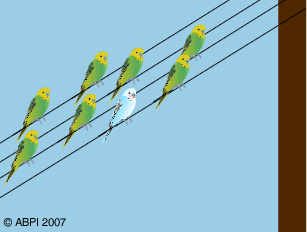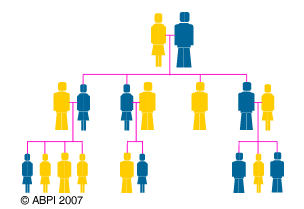What can go wrong?
Mutation

Mutation is a sudden change in a gene or a whole chromosome and will be passed on to new cells by mitosis, or to new individuals by meiosis.
In chromosome mutation an individual may be missing a chromosome or have an extra one. Down's syndrome is caused in humans by the presence of an extra copy of chromosome 21. A gene mutation is a change in the order of bases in the DNA molecule. The change may be very small but could have a severe effect on the individual as in certain diseases, for example, sickle cell anaemia .
Mutations happen randomly and by chance but the risk of mutation is increased by exposure to radiation and to certain chemicals, known as mutagens. If a mutation results in cancer, the mutagens responsible are known as carcinogens.
Most mutations are harmful or even fatal to an organism. However, on rare occasions, a mutation results in a new characteristic which can help the organism survive in unfavourable environmental conditions. The new characteristic will be passed to its offspring who can survive where others may die. This is an example of how natural selection and, over a long period, evolution, occurs.
Inherited diseases
If you are unable to view this animation as you do not have the correct version of Adobe Flash Player installed. Please visit the Abobe website to install the latest version of the free Adobe Flash Player
Cystic Fibrosis, one of the most common genetic diseases, develops as a result of a faulty recessive gene (c) which was identified as recently as 1989. To develop the disease a child must inherit the gene from both parents. If, as in the diagram, both parents are carriers, there is a one-in-four chance that a child will have the disease, a two-in-four chance of a child being a carrier and a one-in-four chance of the child being unaffected.

Unlike cystic fibrosis, Huntington's Disease is dominant, that is, it can be inherited if just one parent has this gene.
The diagram shows what can happen if one parent has the HD gene (and therefore has Huntington's disease) and the other parent does not. In this diagram the presence of the disease is shown by a capital H. In Huntington's the symptoms do not show until the sufferer is 35-40 years of age, by which time the faulty gene may have been passed on to children and even grandchildren.
You are a unable to view this animation as you do not have the correct version of Adobe Flash Player installed. Please visit the Abobe website to install the latest version of the free Adobe Flash Player
Continuing genetic research has meant development of tests for some genetic diseases both in utero and after birth and treatments such as gene therapy.














